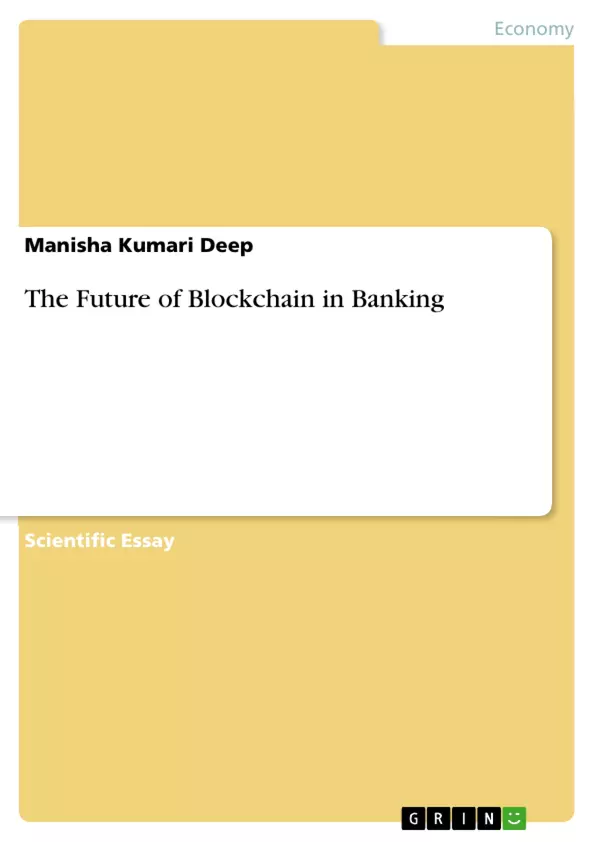Blockchain technology which has been discovered almost a decade ago is one of the disruptive technology of the decade. Every industry is talking about it. It is the most versatile technology being used in almost every industry like pharma, cloud, retail, insurance, banking and so on. In this paper Blockchain technology has been discussed briefly highlighting its characteristics and features. The second section talks about Blockchain in Banking industry and its role and main benefits to this industry. Proceeding section lists out the banks who have successfully used Blockchain technology in their business. Third and fourth section talks about top five factors accelerating and hindering adoption of Blockchain technology and its impact on banking. Last section discusses the future of Blockchain technology in banking. All the points and aspects and have been carefully weighted and interpretation stated on why currently Blockchain cannot be adopted as mainstream technology.
Keywords: Blockchain technology, Private Blockchain, Ledger, Decentralization, Dynamic Trust Management Method (DTMM), Public Blockchain
Other Reads by the Author
The Trial of Hope (Amazon)
An Alien Land (Kobo)
2 Moms (Kobo)
Unfolding Disaster (Kobo)
Walk to School (Kobo)
51 Points in Raising Awesome Kids (Kobo)
Organic IT Infrastructure Planning and Implementation (Amazon)
Grin Books
Positive Employee Recruitment and Retention Vital for Organizations
Digital India Mission. Implications on Social Inclusion and Digital Citizenship
Cloud Computing. DDoS, Blockchain, Regulation and Compliance
Organic eLearning (OE-Learning)
The Way of Prime Minister Narendra Modi's Leadership
Feasibility Study between Continuous Adaptive Risk and Trust Assessment and Organic Networks
I am my supervisor’s slave: Supervisor subordinate relationship is vital for organizational efficiency
Brands and their Shockvertisement Strategies
The Future of Blockchain in Banking
Social Media Marketing: Author’s Quandary Decoded (Amazon)
Inhaltsverzeichnis (Table of Contents)
- Blockchain Technology
- KEY CHARACTERISTICS OF THE OF THE BLOCKCHAIN
- Blockchain in Banking…....
- Top five factors Accelerating Adoption of Blockchain technology.
- Top five factors Hindering Adoption of Blockchain technology
- Future of Blockchain technology in Banking .………………….
Zielsetzung und Themenschwerpunkte (Objectives and Key Themes)
This paper delves into the application of Blockchain technology in the banking sector, examining its potential benefits and challenges. It aims to provide an understanding of Blockchain's characteristics and how it can revolutionize the banking industry.
- Characteristics and features of Blockchain technology
- Applications of Blockchain in the banking industry
- Factors accelerating and hindering the adoption of Blockchain in banking
- The future of Blockchain technology in the banking sector
- The role of public and private blockchains in banking
Zusammenfassung der Kapitel (Chapter Summaries)
The first chapter introduces Blockchain technology, explaining its core principles and key characteristics. It discusses how Blockchain operates as a decentralized, distributed ledger system, ensuring data security and transparency.
The second chapter explores the potential benefits of Blockchain technology for the banking industry. It highlights how Blockchain can enhance security, reduce costs, and increase efficiency in banking operations.
The third chapter examines the top five factors accelerating the adoption of Blockchain in banking. These include increasing demand for secure and transparent transactions, growing regulatory support, and advancements in Blockchain infrastructure.
The fourth chapter discusses the top five factors hindering the adoption of Blockchain in banking. These include concerns about scalability, interoperability, and the need for regulatory clarity.
Schlüsselwörter (Keywords)
The key concepts and terms explored in this paper include Blockchain technology, Private Blockchain, Ledger, Decentralization, Dynamic Trust Management Method (DTMM), and Public Blockchain.
- Citar trabajo
- Dr. Manisha Kumari Deep (Autor), 2018, The Future of Blockchain in Banking, Múnich, GRIN Verlag, https://www.grin.com/document/437795



